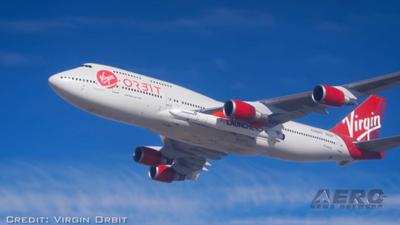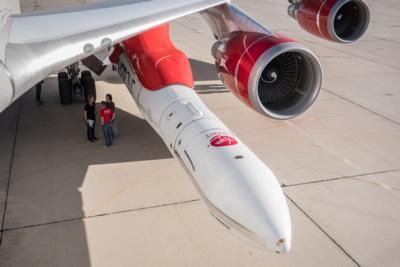VO: The Rocket Did Not Explode
The folks at Virgin Orbit, displaying an uncommon level of transparency (especially this soon after a launch failure) have filed the following report:
Virgin Orbit Report

As we’ve delved into the data from yesterday’s flight, the more we see, the happier we get. We’ve taken an enormous step forward as a team, and we wanted to share more about the flight, including both the many things that went well and what we know about the areas where we’ll need to improve.
The context of everything that happened before the release of the rocket is incredibly important, and we’ll describe that in detail below. But we won’t make you wait for the part that’s of most interest.
What Happened?
For about 9 seconds after drop, the flight went perfectly. Through some of the most challenging portions of our flight — release, the controlled drop, the rocket’s ignition sequence, and the initial portion of guided, powered flight — every part of our system did exactly as we designed it to do. We have solid data from hundreds of channels and sensors — and in looking at those, we see performance that is well-matched to our predictions and to the extensive data we have from our models and ground tests. This means that we have proved out via flight the foundational principles of our air-launch operations, which is the key thing that separates us from our peers in the industry.
About 9 seconds after drop, something malfunctioned, causing the booster stage engine to extinguish, which in turn ended the mission. We cannot yet say conclusively what the malfunction was or what caused it, but we feel confident we have sufficient data to determine that as we continue through the rigorous investigation we’ve already begun. With the engine extinguished, the vehicle was no longer able to maintain controlled flight — but the rocket did not explode. It stayed within the predicted downrange corridors of our projections and our Federal Aviation Administration (FAA) launch license as the vehicle fell to the ocean, posing no risk to public safety, no danger our aircrew or aircraft, and no significant environmental impact.
So, What Did This Launch Demonstration Prove?

Our Launch Demo was the world’s first attempted orbital launch from Mojave Air and Space Port. One of the core capabilities we’ve been working to develop is the idea of a truly mobile launch infrastructure — and yesterday, we completely demonstrated that capability. The infrastructure LauncherOne requires is dramatically different from any existing launch system. For this launch demo, all we needed from the airport was a small plot of land at the end of a taxiway and access to a runway. Everything else we brought in ourselves — coming in on local roads or on our carrier aircraft itself. This low infrastructure footprint is the key to truly responsive launch and a new kind of global launch capability. And we’ve now proven it works.
As part of that, we have proven out our own fully transportable ground operating system. All of the trailers that we use to transport our rocket, mate it to our carrier aircraft, fuel and pressurize it, and service our payload were transported by public roads to the spaceport. Indeed, even some of our most critical ground stations for receiving telemetry were driven and parked in place. Again, this proves out our ability to quickly bring our launch capability wherever it is needed — a whole new category of launch service. Our Launch Demo was also conducted under a Commercial Space Transportation License issued by the FAA, the first time we have ever operated under such a license. Furthermore, this launch was conducted independent of the U.S. federal ranges, important national institutions that can nevertheless impart significant cost and schedule impacts on traditional launches. Apart from coordinating the airspace, our system is beholden to no one’s schedules other than our
customers’, our own, and Mother Nature’s.

One key technology that is required in order to move away from reliance on those federal ranges is an extremely robust autonomous flight safety system. While rockets traditionally rely on complex ground systems at the ranges to monitor the flight and terminate the mission if the flight ever goes out of the approved launch corridor, the new generation of launch vehicles are doing this job autonomously. Yesterday, our rocket demonstrated its capability to correctly know when we are in that corridor and when we are not — something we verify during our “cold pass” prior to dropping the rocket. Thankfully, this system was not needed during yesterday’s mission, but it functioned perfectly throughout the flight.
When Cosmic Girl and LauncherOne took off from the runway at Mojave Air and Space Port just before noon yesterday, that marked our first flight with cryogenic liquid oxygen loaded into the rocket — and only our second ever flight with cryogenic materials on board. Capping an extensive campaign of ground testing, this milestone allowed us to prove out key aspects of the technology behind our linerless composite tanks, which held up to the loads of flight under the wing of a widebody jetliner and the release maneuver while carrying a full load of cryogenic oxidizer.

After a swift flight out to the drop point and a cold pass around our racetrack — the planned loop where we ensure the system autonomously detects when it enters and exits the allowable launch corridor, in addition to verifying telemetry locks — we entered into and executed a terminal count for the first time outside of dress rehearsals. A universal aerospace practice that has been made famous by countless documentaries and films, the terminal count is the final sequence of checks and polls that culminate in a rocket’s ignition and flight. These countdowns always require an uncompromising level of precision, communication, and choreography — and our team pulled it off without a hiccup, hold, or scrub.
As the terminal count approached zero, our carrier aircraft went into our pitch-up maneuver, climbing steeply and achieving a flight path angle of about 30 degrees. Exactly on cue, we cleanly released the LauncherOne rocket from the pylon under the wing of our 747. As planned, the aircraft quickly banked away from the rocket. The rocket itself flew gracefully, with complete control, perfectly matching our predictions and further validating our aerodynamic models.
A few seconds after drop, the rocket trigged its ignition sequence. On our first ever attempt, we achieved in-air ignition and steady state-operation of our main stage rocket engine. The use of liquid-fueled rocket engines for air-launched vehicles is almost unheard of outside of legendary programs like the X-1 and X-15; and indeed, no one before us had ever completed such an ignition of an orbital-class rocket engine.
Once the engine ignited, our guidance and control system controlled the rocketin powered flight and steered it along its trajectory, all as predicted by our 6-DOF analysis.
Each of these items is a huge achievement for our team, and we are thrilled to have accomplished so many of them in our first launch demo mission.
What Next?

With more confidence than ever in our design philosophy and the utility of our one-of-a-kind launch system, we’re determined to reach space as soon as humanly possible. Clearly, we have things to learn and something to fix, but our engineers, technicians, and flight crew have taken a moment to celebrate and are now precisely and thoroughly dissecting the data.
Meanwhile, our integration team is hard at work preparing our next rocket, and the one after that, and several more. If hardware changes are needed, we’ll be able to make them quickly, thanks to our vertically integrated, state-of-the-art rocket factory. And if we decide we want to run a few experiments, well, we’ve got a factory full of flight hardware we can use for whatever tests we need.
It’s too soon to say exactly when our next launch demo will occur. But we can confidently say that we laid the groundwork long ago for us to build on this launch demo quickly and skillfully. We’re excited to take the next step on our journey to open space for good.
 Airborne 04.16.24: RV Update, Affordable Flying Expo, Diamond Lil
Airborne 04.16.24: RV Update, Affordable Flying Expo, Diamond Lil ANN's Daily Aero-Term (04.20.24): Light Gun
ANN's Daily Aero-Term (04.20.24): Light Gun Aero-News: Quote of the Day (04.20.24)
Aero-News: Quote of the Day (04.20.24) Aero-News: Quote of the Day (04.21.24)
Aero-News: Quote of the Day (04.21.24) ANN's Daily Aero-Term (04.21.24): Aircraft Conflict
ANN's Daily Aero-Term (04.21.24): Aircraft Conflict







